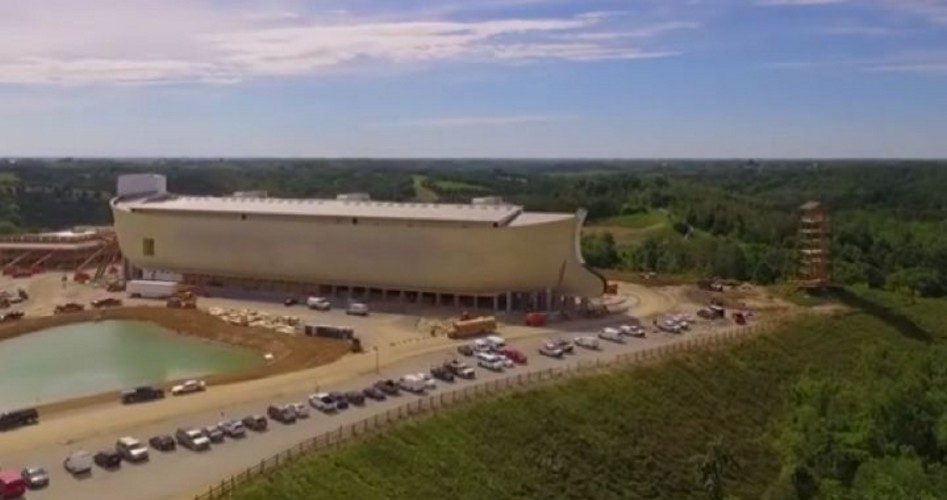
Located about halfway between Cincinatti, Ohio, and Lexington, Kentucky, in Williamstown, Kentucky, a $100 million “Noah’s Ark” exhibit opened this week. The exhibit was built according to the dimensions and specifications found in the biblical book of Genesis, and is 510-feet long.
The seven-story tall structure is the largest timber frame structure in the world.
Predictably, the theme park, which accepts the biblical story of a world-wide flood in which Noah and his family were saved inside the massive ark, along with a multitude of animals, as literally true, has drawn opposition. Leading the opposition is Jim Helton of the atheist group Tri-State Freethinkers, who contends the theme park is a rejection of science. “Basically, this boat is a church raising scientifically illiterate children and lying to them about science,” Helton claimed.
Actually, it is a business, which will charge admission, and collect sales taxes, not a typical church practice. Interestingly, when anti-Christian progressives want to force a pharmacist to dispense certain drugs even if it violates his or her religious beliefs, they say the drug store is a “business” not a “church.” Here, the atheist opponent calls a business a church.
{modulepos inner_text_ad}
Ken Ham, president of Answers in Genesis, was upbeat about the completion of the project, which was first announced in 2010. “People are going to come from all over the world,” Ham predicted. “I believe this is going to be one of the greatest Christian outreaches of this era in history.”
Multiple exhibits are included inside the massive ark, including demonstrations on what life would have been like on the ark. It makes speculations about what Noah’s life was like before the flood, addressing questions such as what he may have looked like, and what he did for a living.
It is estimated that the park will draw a million visitors its first year.
Ironically, the person who may have done the most to get the project completed, other than Ham himself, albeit unwittingly, was Bill Nye, a former TV personality with the series, Bill Nye, the Science Guy. Ham had difficulty raising the necessary funds to construct the theme park until Nye agreed to debate Ham on the issues of evolution and the flood of Noah.
The debate drew a huge online audience, and has been viewed by more than five million on YouTube. Ham’s promotion of the project during that debate rejuvenated the fundraising efforts, leading to its completion. For his part, Nye expressed dismay that his appearance in the debate with Ham played such an important role, lamenting that he was “heartbroken and sickened for the Commonwealth of Kentucky.”
Less than a month after the debate, Ham revealed that a city of Williamstown bond offering raised $62 million for the Ark Project, which led to the breaking of ground at the site of the ark only a few months later.
Ark opponents were particularly incensed by the Ark Project receiving a Kentucky sales tax incentive, estimated to be worth as much as $18 million. Helton predictably charged, “It’s a clear violation of separation of church and state. What they’re doing is utterly ridiculous and anywhere else, I don’t think it would be allowed.”
A federal judge, however, sided in January with the constitutionality of the Ark Project receiving the tax incentive. The ruling stated that Kentucky officials could not impose requirements on the Ark Project that were not also applied to other applicants for the tax incentive. The tax incentive rebates a portion of the sales tax collected at the park.
While one may legitimately argue that state governments should not be offering such tax incentives, it is clear that the opposition here is not a principled opposition to tax incentives in general, but rather to the biblical content of the theme park, and its related hiring practices. Only persons who sign a statement that they “profess Christ as their savior” will be hired. While it is logical that the theme park should be able to restrict its hiring only to those who believe in the mission of the project, atheists such as Helton took exception. Yet how many public colleges (or even private colleges, for that matter) will even consider hiring a person to teach biology who rejects Darwinian evolution?
But the principal objection to the Ark theme park is its message. Secular opponents simply do not believe the flood story is true history or true science.
Ham’s ark is an effort to promote the belief that Noah’s ark was part of a historical event. “Today the world is covered with billions of fossils in rock layers laid down by water — even on top of mountains,” the park’s website asserts, which of course would be the case if there were, indeed, a worldwide flood as described in the Bible.
Certainly, there are stories of a great flood in practically every culture around the world. The gods purified the Earth with a great flood, according to an Egyptian legend. In a Greek story of a great flood, sent as a result of man’s great wickedness, the ark rested on Mt. Parnassus. As part of the Greek account, a dove was sent out twice, which is, of course, found in the biblical narrative.
The Hindus have a similar tradition. In the Chinese legend, Fa-He, considered the founder of China, was saved from a great flood, along with his wife, his three sons, and three daughters. Druids in England believed that the world was re-populated from a righteous patriarch after a flood.
Similar traditions and stories are found among the American Indians, Polynesians, and elsewhere. While differing in some details, almost all of these traditions repeat certain key points: the great evil of humans; a boat that saved the life of a few, almost always eight; and the repopulation of the Earth from this family.
Whether one accepts or rejects the biblical account of the Great Flood, the ark park appears to be a fun site to visit. And the controversy generated by its secular opponents will no doubt increase ticket sales.



